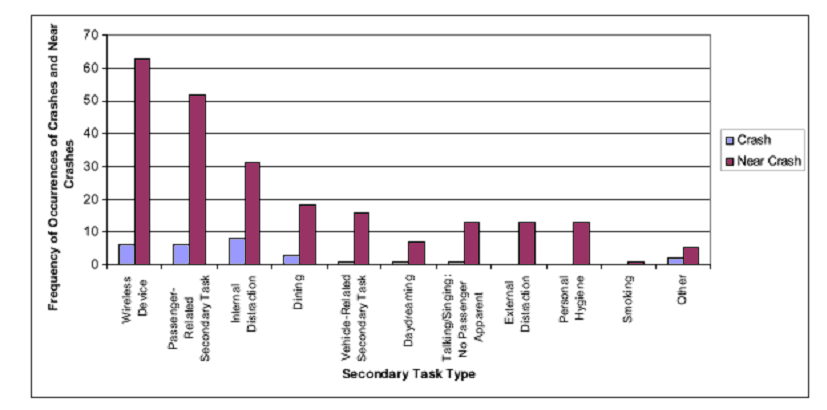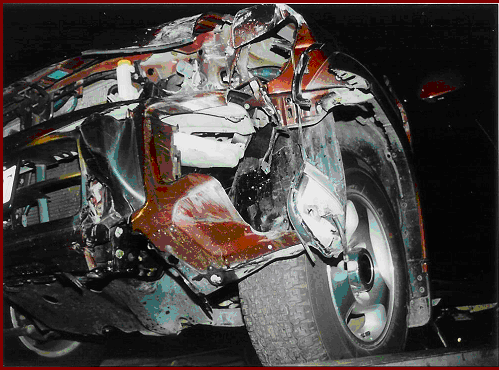rouleau-law.com
815/229-PAIN
229-7246
Automobile Accidents/Crashes
Anyone who has enough experience knows that motor vehicles are extremely dangerous. Former Department of Transportation Secretary Mineta said “Every year this country experiences a national tragedy that is as preventable as it is devastating.”[1] Motor vehicle collisions account for 64% of all personal injury cases filed in Illinois.[2]
The preliminary national statistics for 2005 show that 43,200 died on the nation’s highways in 2005, up from 42,636 in 2004. Injuries numbered 2.68 million in 2005. Fifty-five percent of passenger vehicle occupants who died in 2005 were unbelted.[3]
Almost one (1) percent of the population is injured in motor vehicle collisions every year. [4] The economic cost of motor vehicle collisions to American society in 2000 alone was $230.6 billion. [5][6] This works out to about $820 per person.[7] Given the very large human and social costs of driving our government and many private researchers try to find ways to make motor vehicle travel safer.
Most Collisions Are Due To Driver Error
A National Highway Traffic Safety Administration report[8] was recently completed (April 2006) in which concluded that “nearly 80 percent of crashes and 65 percent of near-crashes involved some form of driver inattention within three seconds before the event. Primary causes of driver inattention are distracting activities, such as cell phone use, and drowsiness.”[9] “The results from the survey and test battery response analyses indicated that drivers with high involvement in inattention-related crashes and near-crashes were significantly younger and possessed less driving experience than the drivers who were involved in fewer inattention-related crashes and near-crashes.”[10] “The high-involvement drivers also self-reported significantly more traffic violations and being involved in more accidents prior to the beginning of the study.”[11] In other words younger drivers and drivers who have histories of traffic violations are more dangerous on the roadways. Did any of us need this study to figure that one out?
The results of the study indicated that “driving while drowsy results in a four- to six-times higher near-crash/crash risk relative to alert drivers. Drivers engaging in visually and/or manually complex tasks have a three-times higher near-crash/crash risk than drivers who are attentive. There are specific environmental conditions in which engaging in secondary tasks or driving while drowsy is more dangerous, including intersections, wet roadways, and areas of high traffic density. Short, brief glances away from the forward roadway for the purpose of scanning the driving environment are safe and actually decrease near-crash/crash risk. Even in the cases of secondary task engagement, if the task is simple and requires a single short glance the risk is elevated only slightly, if at all. However, glances totaling more than 2 seconds for any purpose increase near-crash/crash risk by at least two times that of normal driving.”[12]
An interesting finding of that report showed that a high correlation existed “suggesting that those drivers who are frequently involved in inattention-related crashes and near-crashes are not simply getting “caught” at inopportune moments. These drivers engage in inattention-related activities frequently.”[13] This could easily be the person who describes himself as “accident prone.”
Cell Phones
NHTSA’s policy on using cell phones while driving is conveyed in the following statements from www.nhtsa.gov: “The primary responsibility of the driver is to operate a motor vehicle safely. The task of driving requires full attention and focus. Cell phone use can distract drivers from this task, risking harm to themselves and others. Therefore, the safest course of action is to refrain from using a cell phone while driving.”[14] The recent study found that “cell phone use (10%) was the most frequent secondary task contributor to forward roadway inattention for near-crashes. Most of these cases were during a conversation (i.e., cell phone – talking/listening) as opposed to dialing or answering.”[15]
Comparison of crashes and near-crashes the frequency of occurrences of the presence of a distracting agent as a contributing factor.[16]

From the study it would seem that the use of cell phones while driving seems to be the single
biggest risk that drivers can engage in.
Anyone who drives a motor vehicle should review the materials at the Defensive Driving Courses Information Highway website so that you can minimize the chances of needing a lawyer for an automobile crash. It is our motto that it is always better to have good health than to have a good lawsuit.
If you or someone you know has been injured in a motor vehicle crash that might be someone else’s fault you should contact our offices immediately for a free consultation. We don’t charge unless our client recovers money from someone. Call 815/229-7246 immediately for a free initial consultation.
[1] Transportation Secretary Mineta Calls Highway Fatalities National Tragedy,
Says All Americans Can Do More to Improve Road Safety
[2] 2005 Illinois Verdict Survey, Jury Verdict Research, LRP Publications
[4] 2003 National Statistics—National Highway Traffic Safety Administration
[5] Transportation Secretary Mineta Calls Highway Fatalities National Tragedy,
Says All Americans Can Do More to Improve Road Safety
[6] 2003 National Statistics—National Highway Traffic Safety Administration
[7] Transportation Secretary Mineta Calls Highway Fatalities National Tragedy,
Says All Americans Can Do More to Improve Road Safety
[8] The Impact of Driver Inattention on Near-Crash/Crash Risk: An Analysis Using the 100-Car Naturalistic Driving Study Data, Klauer, S.G., Dingus, T. A., Neale, V. L., Sudweeks, J.D., and Ramsey, DJ, Virginia Tech Transportation Institute 3500 Transportation Research Plaza (0536) Blacksburg, Virginia 24061
[9] NHTSA, Virginia TechTransportation Institute Release Findings of Breakthrough Research on Real-World Driver Behavior, Distraction and Crash Factors
[14] Driver Cell Phone Use in 2005 ─ Overall Results
[15] The 100-Car Naturalistic Driving Study, Phase II – Results of the 100-Car Field Experiment, The Impact of Driver Inattention on Near-Crash/Crash Risk: An Analysis Using the 100-Car Naturalistic Driving Study Data, Klauer, S.G., Dingus, T. A., Neale, V. L., Sudweeks, J.D., and Ramsey, DJ, Virginia Tech Transportation Institute 3500 Transportation Research Plaza (0536) Blacksburg, Virginia 24061
Mark Rouleau 2010 © author reserves all rights to this work.

815/229-PAIN
Defending The Rights Of The Seriously Injured
For More than a Quarter Century
Call for a free initial case evaluation.
The information you obtain at this site is not, nor is it intended to be, legal advice. You should consult an attorney for advice regarding your individual situation. We invite you to contact us and welcome your calls, letters and electronic mail. Contacting us does not create an attorney-client relationship. Please do not send any confidential information to us until such time as an attorney-client relationship has been established.
Copyright 2014
